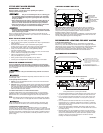
4
LOCKING FEATURES
T
he locking features are designed to discourage unauthorized removal of the battery or alarm. It is not necessary to activate the locks in single-family
households where unauthorized battery or alarm removal is not a concern.
These Heat Alarms have two separate locking features: one to lock the battery compartment, and the other to lock the Heat Alarm
t
o the mounting bracket. You can choose to use either feature independently, or use them both.
T
ools you will need:
•
Needle-nose pliers or utility knife • Standard Flathead screwdriver.
B
oth locking features use locking pins, which are molded into the mounting bracket. Using needle nose pliers or a utility knife, remove one or
b
oth pins from the mounting bracket, depending on how many locking features you want to use.
T
o permanently remove either lock insert a flathead screwdriver between the locking pin and the lock, and pry the pin out of the lock.
L
ocking Pin
TO LOCK THE BATTERY COMPARTMENT
D
o not lock the battery compartment until you have activated the
b
attery and tested the battery back-up.
1
. Activate the battery back-up by removing the
“Pull to Activate Battery Back-Up” tab.
DO NOT remove the battery activation until AC
p
ower is turned on to conserve battery power.
2
. Press the Test/Silence button until you hear a brief acknowledge (or
f
eedback) chirp. The alarm will sound: 3 beeps, pause, 3 beeps, pause.
I
f the unit does not alarm during testing, DO
NOT lock the battery compartment! Install a
new battery and test again. If the Heat Alarm
s
till does not alarm, replace it immediately.
3
. Using needle-nose pliers or a utility knife,
detach one locking pin fro
m the mounting
bracket.
4
. Push the locking pin through
t
he black dot on the label on
the back of the Heat Alarm.
TO UNLOCK THE BATTERY COMPARTMENT
Once the Heat Alarm is installed, you must disconnect it from the AC power
b
efore unlocking the battery compartment.
E
LECTRICAL SHOCK HAZARD. Turn off the power to the area where the
H
eat Alarm is installed before removing it from the mounting bracket.
Failure to turn off the power first may result in serious electrical shock,
i
njury or death.
T
urn off the AC power at the circuit breaker or fuse box.
1
. Remove the Heat Alarm from the mounting bracket. If the unit is locked
to the bracket, see the section “To Unlock the Mounting Bracket.”
2. Disconnect the power connector by gently
p
rying it away fro
m the back of the Heat Alarm.
3. Insert a flathead screwdriver under the head of
the locking pin, and gently pry it out of the battery
compartment lock. (If you plan to relock the
battery compartment, save the locking pin.)
4
. To relock the battery compartment, close the
b
attery door and reinsert locking pin in lock.
5. Reconnect the power connector to the back of the Alarm, reattach the
Heat Alarm to the mounting bracket, and restore the power.
When replacing the battery, always test the Heat Alarm before relocking the
battery compartment.
TO UNLOCK THE MOUNTING BRACKET
ELECTRICAL SHOCK HAZARD. Turn off the power to the area where the
Heat Alarm is installed before removing it from the mounting bracket.
Failure to turn off the power first may result in serious electrical shock,
injury or death.
Always discharge the branch circuit before servicing an AC or AC/DC
Heat Alarm. First, turn off the AC power at the circuit breaker or fuse box.
Next, remove the battery from Alarms with battery back-up. Finally, press
the test button to discharge the branch cir
cuit.
1. Insert a flathead screwdriver between the mounting bracket pin and the
mounting bracket.
2. Pry the Heat Alarm away from the bracket by turning both the screw-
driver and the Heat Alarm counter
clockwise (left) at the same time.
TO LOCK THE MOUNTING BRACKET
1. Using needle-nose pliers, detach one locking pin from mounting bracket.
2. Insert the locking pin into the lock located on the pivoting hinge of the
battery door.
3. When you attach the Alarm to the mounting bracket, the locking pin’s
head will fit into a notch on the bracket.










